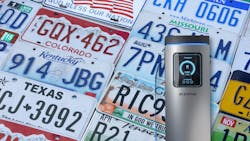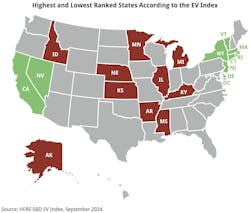A New Study Highlights the Best and Worst States for EV Charging
While electric vehicle (EV) charging infrastructure is rapidly growing in the United States, a new study reveals a stark contrast in progress between states. Some are making rapid strides in building charging networks, while others are falling behind, creating glaring gaps in access. This patchwork approach leaves many areas ill-prepared for the growing demand, highlighting a crucial need for a more balanced expansion of charging stations across the nation.
According to the Department of Transportation, the U.S. currently boasts more than 192,000 publicly available charging ports, with approximately 1,000 new chargers being added each week. While that may sound impressive, it’s just a drop in the bucket compared to the White House’s goal to deploy 500,000 chargers by 2026. Looking further out, the National Renewable Energy Laboratory estimates that by 2030, more than 2 million ports will be needed. It’s clear that the EV charging infrastructure in the United States still has a long way to go.
BriteSwitch, a firm specializing in capturing local, utility, state, and federal rebates/incentives for businesses, takes a look at the current state of EV charging infrastructure and shows which states are the best and worst when it comes to EV charging.
EV Index: A comprehensive metric to evaluate EVSE availability
When looking at the state of the current EV charging infrastructure, it’s not as easy as just looking at the number of chargers. A state might boast thousands of chargers, but if you’re in a remote region and running low on battery, those chargers won’t help unless they are nearby.
To better understand the charging landscape across the country, we can look at the “HERE-SBD EV Index.” This metric was developed by HERE, a location data and technology platform, and SBD Automotive, a global automotive research firm. It’s a comprehensive metric developed to look at all aspects of EV charging. The index scores all states based on the following four criteria, with a maximum of 25 points in each category.
Average charger power: Not all chargers are created equal. Even when looking at Level 3 / DCFC charging, the power of the charger can vary greatly. The more powerful the charger, the faster you can charge and free up the spot for the next driver.
Charging points per mile of road: Having a bunch of chargers in one spot doesn’t help cover a whole state. This metric assesses the ratio of available chargers to the length of roads, allowing for better comparisons between states of different sizes.
EV market share: Each state’s score is determined by comparing the number of EVs on the road to the number of internal combustion engine (ICE) vehicles.
EVs per charging point: This metric indicates the likelihood of finding an available charger. Only three states and Washington DC currently have the optimal ratio of EVs to public chargers.
Best and worst states for charging infrastructure
According to the EV Index, 80% of the highest-ranked states were in the Northeast, with the remaining two states on the West Coast. The lowest-ranked states were mostly in the center of the country (see Map below).
Best states for charging infrastructure
1) Delaware (79.4)
2) Washington, DC (72.5)
3) Massachusetts (64.2)
4) Nevada (64.2)
5) Connecticut (63.7)
6) New York (62.3)
7) California (61.8)
8) Vermont (60.8)
9) New Jersey (60.3)
10) Rhode Island (60.3)
Worst states for charging infrastructure
51) Alaska (19.6)
50) Arkansas (33.3)
49) Idaho (35.3)
48) Nebraska (37.3)
47) Minnesota (40.7)
46) Mississippi (40.7)
45) Kentucky (42.1)
44) Michigan (42.1)
43) Kansas (42.2)
42) Illinois (42.2)
Rebates seem to play a role in the success of EV infrastructure
Rebates are not factored into the EV Index, but looking at the list, it’s no coincidence that the states with the lowest scores also have some of the worst incentives for EV chargers. Currently, 80% of the United States is covered by a rebate or incentive for a commercial EV charger, with an average of $3,488 for a Level 2 and $33,167 for a DCFC.
Alaska has the lowest EV Index score in the country. Only one electric utility, which covers about 5% of the state, currently offers an incentive for commercial chargers. Looking at Arkansas, which ranked 50th on the EV Index, coverage is much better, with 79% of the state being covered by a rebate or incentive for installing a commercial EV charger. However, the average rebate for a Level 2 charger is only $500, a quarter of the average across the United States.
Looking at more successful states, Washington D.C. has a variety of incentives available. The district has a commercial tax credit of 50% of the project cost up to $10,000 per station for a Level 2 charger. In addition, the local electric utility, PEPCO, provides a make-ready program that covers the cost of electric supply infrastructure. New York, which also has a high rating, has more than 19 different rebate and incentive programs available across the state, with some of them targeting specific applications like multi-family properties and disadvantaged communities.
At-home charging helps as well
One portion of the market that the EV Index doesn’t look at is at-home charging. While public charging infrastructure is critical for reducing range anxiety, at-home chargers can also alleviate some of the burden of public charging. Thankfully, rebates are also available for home chargers, with 56% of the nation currently covered by residential incentives averaging $534 per charger.
The future outlook for EV charging
Looking ahead, the future of EV charging infrastructure will depend on sustained investments and the expansion of rebate programs. There’s a long way to go to achieve the goal of 500,000 chargers by 2026. The study by HERE-SBD indicates that while significant progress is being made, considerable challenges remain providing great opportunities for those in the EVSE space. Demand for improved EV infrastructure will increase over the next decade, and they’ll need equipment suppliers, installers, maintenance, and software.
About the Author
Randy Young
Director of Marketing and Data Solutions
Randy Young is the director of marketing and data solutions at BriteSwitch, a company that specializes in finding and capturing rebates for businesses. He can be reached at [email protected].


